Solar Molding of Audio Components Speaks Volumes
By Kate Bachman | December 6, 2013
Category:Imagine this: You drive down a dusty gravel road in a remote, sunny region of California, road dust swirling up in a cloud behind you, until you stop your Benz and get out to survey your plant’s operations. Your factory has no walls, no roof, no floor other than the ground beneath your feet. Horses graze up on the hill beyond you.
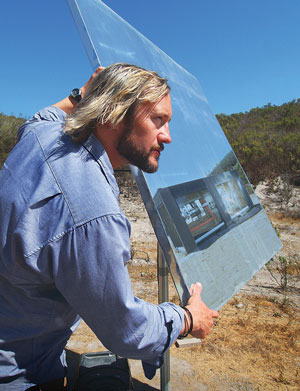 You glance over at your power source—a bank of 20 or so computer-controlled, mirror-like structures called heliostats. They are in full operation on this sunny, 72-degree day (see Figure 1), making occasional clicking sounds as they focus solar thermal energy onto a black structure across a field of patchy grass.
You glance over at your power source—a bank of 20 or so computer-controlled, mirror-like structures called heliostats. They are in full operation on this sunny, 72-degree day (see Figure 1), making occasional clicking sounds as they focus solar thermal energy onto a black structure across a field of patchy grass.
You talk to an engineer sitting at a portable table in the shade behind the heliostats, armed with a slender laptop. Sporting cargo shorts, an indie band T-shirt, and flip-flops, he assures you that the temperature in the rotational mold has maintained 350 degrees F—the temperature needed to melt the polyethylene in the mold—for the required duration and that the hollow molded part is ready to begin cooling.
You cross over to the open rotational molding operation 70 feet away, careful not to walk between the heliostats and the molding process to avoid feeling the intense, oven-like heat directed from the heliostats to the mold (see Figure 2). The mold is tumbling in a rotational molding armature within the confines of half of a 20-ft., repurposed ocean shipping container.
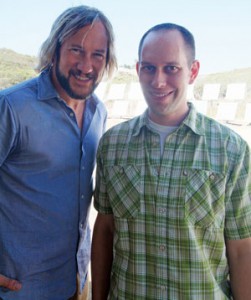
Karl von Kries, LightManufacturing CEO (left), and his brother Rodger von Kries, Technomad vice president, collaborated to develop a practical way for LightManufacturing, acting as a contract manufacturer, to rotomold Technomad’s plastic, waterproof outdoor audio speaker cabinets using concentrated solar thermal energy as the power source to melt the polyethylene raw material.
Your engineer inputs some numbers on the wireless laptop, presses Enter, and the array of heliostats begins to shift from that operation to an adjacent operation in another chamber of the shipping container. Once the heliostats finish shifting and the rotational molding
armature stops spinning, you pull on some suede welder’s gloves, enter the mini-factory from its open side, and open the mold to let it air-cool (see Figure 3).
You then step to an adjacent micro-factory, pull out a mold that has already cooled to 210 degrees, and extract the part.
You’ve just produced a rotationally molded component without a physical building, natural gas, kerosene, power-lined electricity, water, massive oven, or six-figure traditional rotational molding machine. Your only safety gear is a pair of good sunglasses, gloves, and SPF-50 sunscreen, and your most likely workplace hazard is a sunburn or a stubbed toe.
It is the year … 2013, and you are LightManufacturing CEO Karl von Kries (see lead image).
Rotational Molding Outdoor Audio Speakers Outdoors
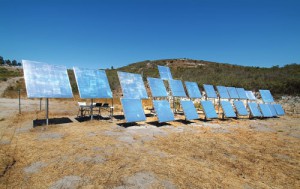
Figure 1:
An array of 23 concentrated solar thermal heliostats reflects the sun directly onto a rotational mold. Each mirror-like heliostat focuses 2,000 watts at peak onto the mold, enough to bring the temperature to 350 degrees F. The heliostats are mounted on sun-tracking devices that are also used to shift the heat source toward or away from the operation. The low-cost reflectors, made with a thick PET Mylar film, are 90 percent reflective.
The energetic and inventive von Kries had headed up product development at a large rotomolding company in Massachusetts, and then struck out with his brother Rodger in 1995 to found commercial audio systems company Technomad, also in Massachusetts. The audio company’s “ruggedized,” waterproof plastic speaker cabinets, which house loudspeakers and amplifiers, are manufactured using rotational
molding.
Rodger heads up Technomad’s operations. He oversees the design and manufacture of the cabinets, other speaker components, and assembly (see Figure 4).
Rodger has an affinity for the durable, you might say. He, like Karl, is a musician and owns a stable of “dinged out” vintage guitars, including a Hofner archtop, National, Gibson, and a ’60s Capri. “I like the marks of age,” he said.
To fortify the cabinets, Rodger specs mill-quality, UV-stable polyethylene resins and wall thicknesses of 3⁄8 to ¾ inch. He regards the rotational molding process as ideal for manufacturing the heavy-duty speakers because it allows the forming of the thick walls to impart higher impact strength.
“In rotational molding, the material naturally builds up more in the corners and ports, which is where you want it for strength. The cabinets last outdoors for 20 years and longer,” Rodger said.
The company’s speakers are used in exterior environments all over the world in theme parks, cruise ships, ski resorts, military training camps, and athletic fields. They’ve amplified sound in sites as diverse as the Queen Elizabeth cruise ship, Universal Studios, the White House, and Sturgis’ Knuckle Saloon.
Although happy with the market success of the speakers and convinced that the rotational molding process is pivotal to that success, the von Kries brothers were uneasy about the process’s environmental ramifications.
Heat, Cool
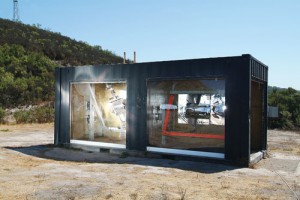
Figure 2:
Two operations—rotational molding of an audio speaker cabinet and cooling a water tank—are performed inside a 20-ft.-long, modified, repurposed ocean shipping container. The array of heliostats provides radiant heat, which heats the plastic directly, rather than heating everything around it, to bring it to melting temperature. The heliostats’ tracking devices alternate the solar heat’s focus from one operation to the other, allowing the mold on the unheated side to air-cool without being repositioned and without quenching. The only electricity required for the 1-HP motor to rotate the mold is provided by a battery.
The conventional rotomolding process is energy-intensive and energy-wasteful, the von Kries brothers contend. “It was always in the back of my mind that there was something intrinsically not optimal about rotomolding,” Karl said. “You’re using fossil fuels to generate all of this heat, and then desperately trying to get rid of it in the next phase of the cycle, flushing it with air and water to cool the part down.
“The thing about it is that air is actually a lousy way to conduct heat. You’re trying to heat this hollow metal mold using hot air around it so you need really hot air. Everything inside the chamber ends up being about 600 degrees F because that’s the ambient temperature of the air.
“It was wasteful to pump this stuff out that you created at great expense. As an engineer, that always nagged me. Is this wise? Is this the best we can do?”
Rodger said he strives to operate Technomad in an environmentally friendly manner. “The sustainable aspect about rotational molding is that it is a very low-waste process because whatever’s put into the mold is part of the product.” In addition, the company sources postindustrial regrind and postconsumer recycled polyethylene for the raw material. Comparable speaker cabinets constructed of birch plywood generate a lot of waste, Rodger said.
“I was searching for a way to take the next step in reducing our carbon footprint,” Rodger said. “The conventional equipment requires a sizable factory and high electricity consumption. And there’s no denying its contribution to greenhouse gas emissions.
“Usually if there’s pollution and waste, there’s also inefficiency and money loss, so there’s a self-interested reason to do the right thing,” he added.
Solar Thermal Melts Plastic Directly
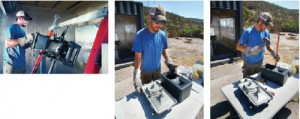
Figure 3:
LightManufacturing Field Engineer Alex Boice extracts the rotationally molded audio speaker cabinet from its bottom mold in the open-sided mini-factory, which is housed in a repurposed shipping container. He then removes the top of the mold and cleans out the slugs.
Karl’s move to California three years ago presented that “next step” opportunity. He was captivated by the state’s solar energy environment and witnessed the coming online of the 250-megawatt Carrizo Plain concentrating solar thermal ranch in San Luis Obispo County. The engineer in him swelled up. “Our collective concern about sustainable business and reducing climate change impact led to my thinking, ‘I really need to do something with this idea. What can I do?’”
Many industrial processes need energy as heat or steam rather than electricity, Karl explained. “And then it just struck me that instead of trying to use the common outputs of solar—electricity or steam—and somehow trying to pipe that into rotomolding, that we could actually use the radiant heat directly. Once I had that insight, then the rest of it kind of fell into place [see Figure 5].
“With direct solar thermal technology, we’re able to use solar in its raw form; therefore, we don’t have the inefficiencies of converting it into something else. It’s just the direct application of solar thermal energy to manufacturing processes.”
Rodger said that things fell into place for him as well. “It’s really exciting because Technomad, like a lot of manufacturers, was looking to have a lower environmental impact, to be more sustainable. We use heat in our industrial process in a lot of ways, but plastics molding is sort of the low-hanging fruit, so it’s the operation that we looked at first.” LightManufacturing is now rotomolding Technomad’s compact Vernal and Vienna speaker cabinets.
How Concentrated Solar Thermal Power Works
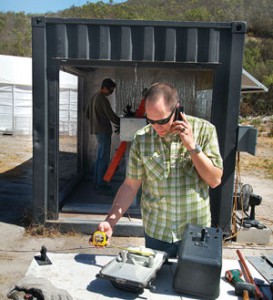
Figure 4:
Technomad Vice President Rodger von Kries quality-checks a recently molded audio cabinet and its mold. The solar rotomolding process can maintain the audio speaker cabinet’s intricate details.
Karl explained how the process works. The heliostats are sun-tracking mirrors reflecting light onto a target. Each heliostat delivers 2,000 peak watts onto the molding operation.
As the sun moves across the sky, the tracking devices make small adjustments based on astronomical math to move the reflectors just enough so that the reflected light stays steady on the target (see Figure 6).
“If you have a bank of heliostats all directing light onto the same target, then for each mirror that you reflect onto that target, you add one sun intensity. So two, three, four heliostats directing the reflected light onto that same target doubles, triples, quadruples the sun intensity. Twenty heliostats heat 20 times the power of the sun at a target,” Karl said.
Low-Cost Angle
The process is both green and less costly, Karl said. It is not only solar energy’s free thermal aspects that reduce its operational costs, it is the stripping down of the massive, complex, and expensive manufacturing process equipment as well.
According to Rodger, a large industrial infrastructure is required to perform conventional, three-stage rotational molding, including the rotomolding machine, and an oven that can be as large as 20 ft. square. The mold is positioned at the end of one of three arms and swung into a gas-fired oven at 600 degrees. The mold is rotated on two different axes in all dimensions to distribute the plastic. “So it’s a large space and it’s heated. Everything gets very, very hot,” Rodger said.
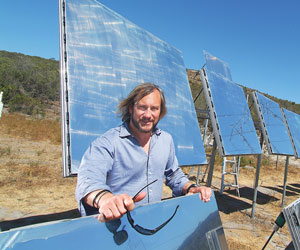
Figure 5:
Karl von Kries was inspired by the Carrizo Plain concentrating solar thermal ranch and driven by his environmental inclinations to apply his ingenuity to developing a method to apply solar’s thermal properties to direct process heat.
Once the mold is heated sufficiently to melt the plastic, the whole wheel inside turns and the tool is brought inside a water-cooling chamber. “Also a big elaborate setup,” he said.
In a third operation, the machine rotates the mold to a workstation where the part is extracted and reloaded with more raw material. “So a big, heavy machine is needed to move the mold between these different workstations,” Rodger said.
Karl explained how the solar process differs. “Conversely with solar rotational molding, first we’re using free solar thermal energy to radiantly heat the mold. We’re pointing heat right at the black mold so it heats it up the same way a radiant space heater heats you but not necessarily the space between. The heat transfer is much more efficient. Everything in the chamber doesn’t have to get hot, only the mold.”
Second, the mold stays in one place. The heat is removed simply by moving the light beam away from the mold by changing the angle of the mirrors. “So that means you don’t spend all of this money on equipment to move the molds around and you don’t need a water-cooling chamber,” Karl said.
Third, because the heat is radiant and direct, the temperature doesn’t need to reach 600 degrees. “It’s only 180 degrees in the chamber, rather than 600 degrees. You can actually be in there while it’s molding,” Karl said. “The mold gets the heat, not the surroundings.”
Finally, the lower temperature and air-cooling method eliminate the need for water quenching. “So you eliminate both the gas consumption and the water consumption from the process.
“Zero energy. Zero emissions. Zero water,” Karl said. “It’s the only solar process I know of that’s both cheaper to buy into and cheaper to operate than the traditional alternative.”
Because Technomad outsources the rotomolding of its cabinets to both LightManufacturing and another traditional rotational molder in Massachusetts, and therefore does not have rotational molding equipment in-house, cost comparisons are between those two contract manufacturers. “For Technomad, it is cost-neutral,” Rodger said.
Factory in a Box: Will Travel
Figure 6:
Rodger and Karl von Kries get some relief from the heat of their power source while monitoring the software controlling the heliostats’ tracking system.
Manufacturers interested in accessing the technology can contract out to LightManufacturing, as Technomad does, or in early 2014 will be able to purchase the whole turnkey system themselves to use in a standard industrial park environment or undeveloped land without any infrastructure. “One of the most exciting aspects of the technology is it allows you to cheaply put small factories near
customers,” Karl said.
The small, portable microfactory—a modified shipping container with the heliostats packed inside—can be delivered by flat-bed and set up in a day or so.
Technomad’s slogan, Audio. Anywhere™, could be modifed as LightManufacturing’s slogan: Manufacturing. Anywhere.
Not for All Climates
Karl concedes that the solar thermal process is not a good fit for colder, cloudier climates. “On the other hand, about 49 percent of the world is hot and sunny. Where you can do this process really cost-effectively is in the U.S. Southwest, Mexico, Central America, Australia, most of Africa, and much of Asia. Does it fit every place on the planet? Iceland in the winter? Definitely not, but are there a lot of places where you can do it year-round? Absolutely.”
The variability inherent in the process raises questions about its fit as well, Karl said. “Well, all of the food we eat was grown on an industrial basis in variable weather conditions. And yet it’s very predictable that we can get our food. So if you need to make a specific number of items by tomorrow afternoon, this is not the right process, but if you need thousands of something to be made over a three-month period, you can average out those variations.”
Broad Industrial Applications
Rodger said he is pleased that LightManufacturing’s solar thermal molding technology is viable and he plans to expand the product lines that he is contracting out to LightManufacturing. “The technology turned out not only to be possible, but it worked out really well.”
While LightManufacturing first focused on plastic molding, Karl sees a host of other industrial applications for direct solar thermal energy. In November the U.S. Patent Office approved 14 of the company’s patents, and patents have been filed internationally as well.
“This is a disruptive technology in its first commercialized state. We think this is the beginning of a really big trend.” Karl added, “It’s been exciting.”
Photography by Pete Bleyer for Green Manufacturer.
LightManufacturing Systems, 415-796-6475, karl@lightmanufacturingsystems.com, www.lightmanufacturingsystems.com
Technomad, 617-906-5934, rvk@technomad.com, www.technomad.com

Side by side, we move metal fabrication forward.
FMA unites thousands of metal fabrication and manufacturing professionals around a common purpose: to shape the future of our industry, and in turn shape the world.
Learn More About FMA
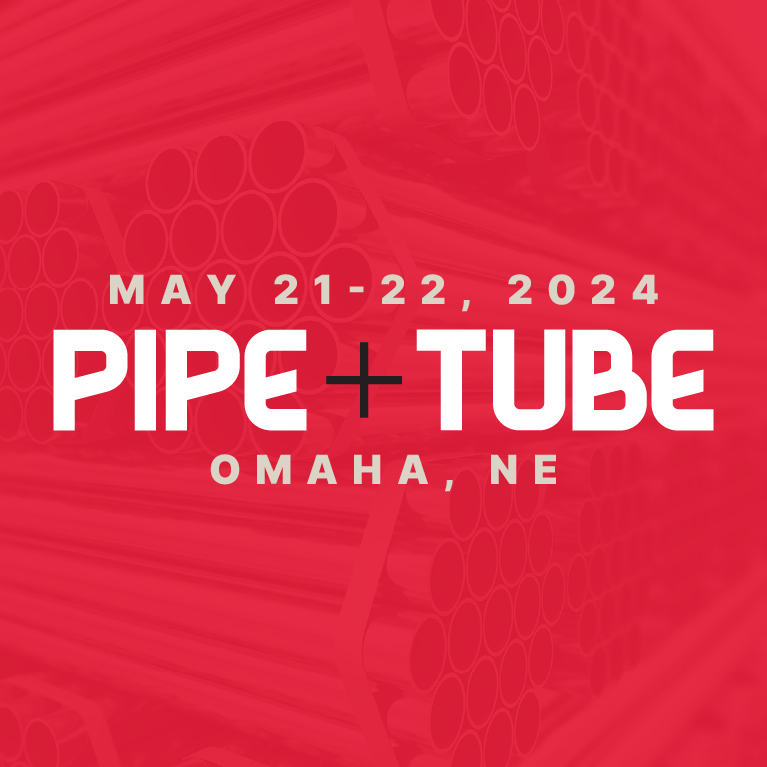
.jpg)
